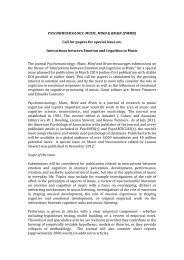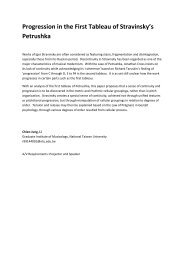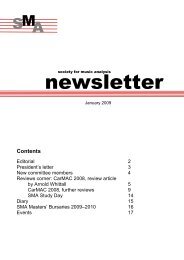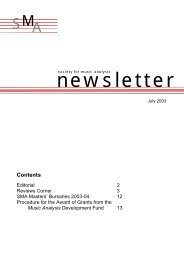Review - Society for Music Analysis
Review - Society for Music Analysis
Review - Society for Music Analysis
Create successful ePaper yourself
Turn your PDF publications into a flip-book with our unique Google optimized e-Paper software.
giving examples of how themes from the first exposition were reused throughout the<br />
movement and then the sonata as a whole. All three papers sparked fruitful<br />
discussions that continued into the following coffee break.<br />
Session 2: Analysing <strong>Music</strong> in Transition<br />
Chair: Dr Kenneth Smith<br />
Daniel Holden (University of Leeds): Varying the Variant: Motivic Processes<br />
in the Finale of Mahler’s Sixth Symphony’<br />
Frederick Reece (Harvard University): ‘Hugo Wolf’s Harmony as<br />
Weitzmannian Critique: The Augmented Triad and its Hexatonic Shadows’<br />
Miona Dimitrijevic (University of Strasbourg): ‘The Formal <strong>Analysis</strong> of Max<br />
Reger’s Orchestral Works’<br />
Martin Curda (Cardiff University): ‘In Search of Modern Moravian <strong>Music</strong>:<br />
Tradition and Innovation in the String Quartets of Janáček’s Students from<br />
the 1920s’<br />
Fortified by refreshments, the delegates reconvened <strong>for</strong> the second session,<br />
which opened with Daniel Holden’s paper on motivic processes in the finale of<br />
Mahler’s sixth symphony. Taking Theodor Adorno’s premise of Mahler’s ‘variant<br />
technique’ (constantly trans<strong>for</strong>ming motifs) as his starting point, Holden set out to<br />
show that there are more categories of motivic development in Mahler’s<br />
compositional process. He demonstrated through vividly animated audio-visual<br />
diagrams the development of individual musical segments. We gained a real sense<br />
of how Mahler used motivic ideas and patterns, not only through variation, but also<br />
by restatement, development and re-derivation. Furthermore, Holden’s presentation<br />
revealed how these many motifs were ultimately derived from two basic ones.<br />
Frederick Reece (Harvard University) explored the harmonic language of Hugo Wolf<br />
in two Lieder: Abschied and Das Ständchen. He began with Wolf’s structural<br />
harmonic use of the augmented triad, explained through a combination of insights<br />
from the nineteenth-century German theorist Carl Friedrich Weitzmann and presentday<br />
perspectives largely indebted to Richard Cohn. Expanding the Weitzmannian<br />
model after Cohn, Reece demonstrated how these augmented triads could become<br />
hexachordal structures and then showed how Wolf applied these in his modulations<br />
and the harmonic structure of the two Lieder.<br />
The final paper of the day, presented by Martin Curda, examined a dilemma that<br />
faced students of Janáček in the 1920s: namely their desire to preserve and develop<br />
his legacy whilst finding a compositional voice independent of his. More specifically,<br />
he looked into how Vilém Petrželka, Václav Kaprál and Pavel Haas dealt with this<br />
dilemma against the backdrop of an awareness of Moravian musical tradition in the<br />
newly established Czechoslovakia. Through selected excerpts from string quartets<br />
and by referring to small and large-scale structures, diversity of tempi, textures and<br />
stylistic emulation, Curda compared these Janáček pupils not only to their renowned<br />
teacher, but also to each other.<br />
Editor’s note: The keynote address is reviewed towards the end.







